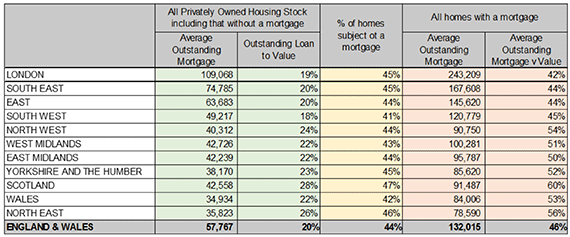The latest figures on mortgage lending from the Council of Mortgage Lenders show that homebuyers are continuing to borrow more relative to their income. We expect mortgage regulation to limit this in the future, but to understand what this means for different parts of the housing market it is important to understand levels of equity relative to debt.
We know from our analysis of the total value of homes in the UK that levels of equity have risen significantly more than levels of borrowing over the past five years. Total privately held housing equity now stands at £5.1tn.
In five years this equity has risen by £1.7tn, while mortgage borrowing has only increased by £106bn. But the benefits of rising equity gains have been unevenly spread. Almost six out of ten homes (57%) are now mortgage free, meaning that mortgage borrowing is spread across just 43% of all privately owned homes.
Across England and Wales borrowing totals are around £1.2tn, which equates to an average of around £132,000 per mortgaged household. That figure has risen by £18,500 over the past five years as existing debt has been concentrated among a smaller number of home owners. Meanwhile, while at a regional level there is relatively little variation in the percentage of homes with an outstanding mortgage, average levels of outstanding debt vary enormously.
Unsurprisingly, London has the highest average outstanding mortgage at almost £110,000 across all homes. This figure rises to over £243,000 for those with an outstanding mortgage. However, despite much higher levels of outstanding debt in London, the equity held by those with a mortgage is also greater than in any other region, reflecting the capital’s high house price growth over the past decade. Just five years ago the average outstanding loan-to-value for a property in the capital subject to mortgage stood at 49%. It now stands at 42%, the lowest of any region.
This gives home owners a significant store of wealth and lenders an equity cushion. Instead it will be the debt relative to a borrower’s income that will act as a constraint on people’s ability to trade up or get on the housing ladder and this is likely to slow house price growth in the capital.
The South East and East rank second and third to London in terms of average outstanding mortgage on homes with borrowing, at £167,608 and £145,620. Here levels of equity are high without quite the same debt constraints.
At the other end of the scale, the North East has the lowest average borrowing for homes with a mortgage, at £78,500 and loan-to-income ratios are not a huge constraint here. But it also has the highest outstanding loan-to-value ratio, at 56%, meaning a lack of equity for home owners is a bigger consideration.
This lack of equity is a very real constraint in some markets that have seen very weak house price growth over the past 10 years. For example, in markets such as Blackpool, Blackburn, Burnley and Middlesbrough outstanding loan-to-values exceed 70%, making it difficult for those looking to move to take on more debt on competitive terms.
Lucian Cook is director of residential research at Savills












